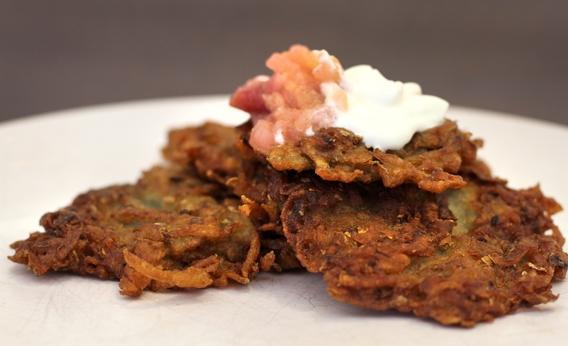Hanukkah has been marketed in America as a substitute Christmas, its gift-giving aspect played up to make Jewish children feel better about Santa’s conspicuous absence from their lives.
This framing of the Festival of Lights does a huge disservice to everyone involved. Presents are not traditionally a huge part of Hanukkah celebrations, and yet Hanukkah still has a major advantage over Christmas—and every other holiday: It’s a festival devoted to frying things. To celebrate the Maccabees’ one-day supply of oil magically lasting for eight days, Hanukkah celebrants cook with copious amounts of oil. It is the best commemoration of a minor ancient miracle anyone has ever come up with. (Better, even, than Johnny Cash’s “He Turned the Water Into Wine.”)
Latkes, of course, are the best known of the foods fried during Hanukkah, for an obvious reason: Who doesn’t love fried potatoes? Approaches to the latke vary widely, however. On one end of the spectrum are the minimalists who think the only ingredients that belong in latkes are potatoes, salt, and just enough oil to fry them. This is not a good approach. For one thing, latkes are not hash browns; they should be moist and a little doughy within, a texture potatoes can’t achieve on their own. For another thing, clumps of grated potato fall apart when you try to flip them.
On the other end are those who take the pancake part of potato pancake literally, adding enough eggs and flour to make a small Dutch baby. There are limits to this strategy—you do not want latkes to taste like bread—but it’s mostly the right way to go. You need eggs for moisture, a little flour to soak up the potatoes’ excess liquid, and both eggs and flour to bind the potatoes so they don’t disintegrate in the pan. The threat of breadiness is ever present with flour, though, so I substitute instant mashed potatoes for part of the flour, as they absorb liquid while adding additional potato flavor and texture. (Yes, I was dubious, too, when I first heard this notion through the grapevine, but it works. If it makes you feel any better, the tipster who suggested this is Israeli.) A tiny bit of baking powder prevents the soft latke innards from being so dense that they resemble paste.
Those innards should be soft, though: Don’t cook your latkes until they’re evenly, deeply brown on the surface, because by that point they’ll be overcooked within. Aim for a mottled, golden-and-tan look instead. And do not think you can get such a look by using just a few tablespoons of oil—you need enough that each pancake floats. Finally, although latkes are usually fried in a skillet, a large pot is a much better vessel for the task. The low walls of a skillet allow oil to splatter everywhere while you’re frying, including your countertops, walls, and arms. Yes, Hanukkah is a holiday about oil, but I don’t think the Maccabees would want you subjecting yourself first-degree burns, stained clothes, and grimy ranges. Higher walls will keep the oil where it belongs: inside the pot, doing God’s work.
Latkes
Yield: 16 to 18 four-inch latkes
Time: About 30 minutes
2 pounds russet or other starchy potatoes
1 large yellow onion
2 large eggs
¼ cup all-purpose flour
2 tablespoons mashed-potato granules
2 teaspoons salt
Scant ¼ teaspoon baking powder
Scant ¼ teaspoon black pepper
1 to 1½ cups extra-virgin olive oil
Sour cream and applesauce for garnish
1. Cut the potatoes and onion into large chunks, then grate them with the grating disk of a food processor. Transfer them to a strainer set over a large bowl, and drain for 10 minutes, occasionally pressing down on the vegetables to squeeze out their liquid.
2. Gently pour off and discard the potato water, leaving the potatoes’ starch in the bottom of the bowl. Transfer the grated vegetables to the bowl, and add the eggs, flour, mashed-potato granules, salt, baking powder, and pepper. Stir to combine.
3. Put ½ inch of olive oil in a large pot over medium-high heat. (The volume will vary depending on the diameter of your pot.) When it seems hot, add a spoonful of the potato mixture; it should sizzle immediately. Working in batches, add the potato mixture ¼ cup at a time, flattening each mound into a thin disk. Cook the latkes until golden brown, 2 to 3 minutes per side, then drain them on paper towels. Serve hot, garnished with the sour cream and applesauce.
Previously in You’re Doing It Wrong:
Gingerbread Cookies
Mashed Potatoes
Charoset
Pancakes
Christmas Bread
Eggnog
Fruitcake
